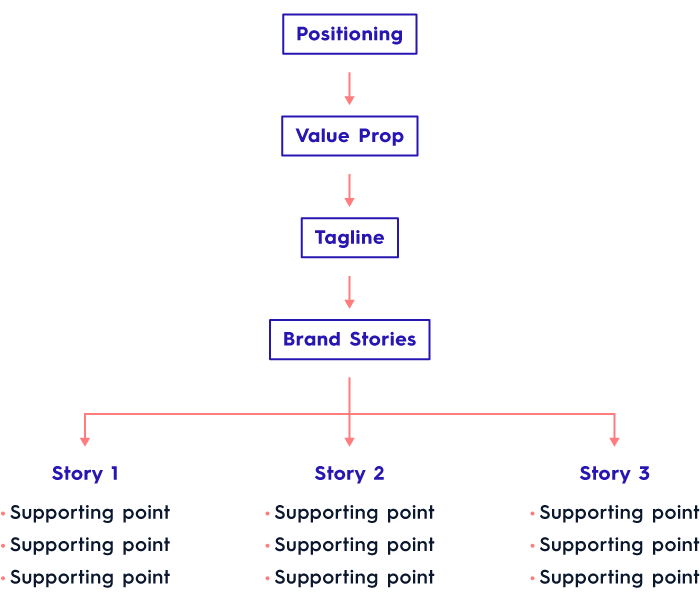Contrary to popular belief, your brand strategy and your content strategy aren’t the same thing, nor do they function independent of each other. They’re actually symbiotic. Your brand strategy informs your content strategy, and your content strategy helps execute your brand strategy. Ultimately, they both serve the same goal: to strengthen and grow your brand.
Still, we know plenty of marketers are a little confused on the distinction, so let’s review:
- Brand Strategy: A brand strategy is the blueprint for how you build and grow your brand. It encapsulates and articulates who you are, why you exist, what you do, and how you communicate. It’s the foundation of your business. (For a deeper dive, here’s more on what it is, what it includes, and how to create one.)
- Content Strategy: A content strategy is a way to execute your brand strategy; a tool to communicate who your brand is and what you’re about—through content. (See our step-by-step guide to create and document your content strategy if you don’t have one yet.)
Unfortunately, in many organizations, there is a disconnect between content strategy and brand strategy—assuming there’s a documented content strategy at all. (Only 37% of marketers have one, according to the Content Marketing Institute’s 2018 B2B Benchmarks report.)
The Content Strategy vs. Brand Strategy Struggle
Many marketers are being pulled in a million different directions, especially those working for early- to mid-stage startups. (It’s even worse for B2B tech startups.) There is tremendous pressure, and teams are working in silos. Because startups must have product-market fit ASAP, they must have customers to decrease their burn rate and increase the likelihood they can survive, grow, and raise more money to keep the company going.
Thus, teams are usually focused on:
- Building the product
- Selling the product
Marketers are so focused on immediate tactics and benchmarks that they have little time to devote to long-term thinking or to connect what they’re doing to brand strategy. The “brand” always takes a backseat to what needs to be done today. (Understandably, it’s hard to focus on the long term if you’re worried you won’t be around in 6 months.)
Fairly consistent CMO turnover doesn’t help much either. (According to Spencer Stuart’s 14th annual CMO tenure study, the average CMO tenure is 44 months.)
And this is where the problem lies.
When branding does become a conversation, it’s usually long after the company has been marketing and selling (and gone through a few CMOs). By that time, camps are often siloed or simply focused on their own thing. There is no brand, no long-term thinking, and therefore no way to genuinely connect with target consumers.
So what happens to the company?
- They have a hard time competing, often because they don’t stand out.
- They realize their growth-hacking efforts have temporary results.
- There’s no emotional connection between the brand; therefore, their customers have no loyalty.
- Commoditization happens.
That’s when they find themselves in the middle of an existential branding crisis—and marketers suffer most. No matter how strong their content operation may be, they are creating content that doesn’t serve a larger purpose and, therefore, doesn’t really move the needle.
How to Align Your Content Strategy with Your Brand
To build a healthy brand, you need to work with intention. Everything from your values to your voice affects how you do business—and, most importantly, how you’re perceived. A misaligned content strategy not only dilutes but actually damages your brand.
So how do you make sure your content strategy is anchored to your core brand strategy? Here are 6 ways to do it.
1) Use Brand Stories
Your brand strategy should include messaging architecture that gives you a blueprint for how to communicate your brand identity. It’s how you talk about your products/services, your people, and your business, whether it’s on your site or in your Twitter bio.
That messaging architecture should include your positioning, value prop, tagline, and supporting brand stories.

When you ideate for content ideas, consider your brand stories. Everything you create should reflect at least one of them. Also, a convenient benefit of articulated brand stories is that they can be tailored for many different channels and target personas. Sometimes you may vet your ideas through them, and sometimes you may use them to inspire your next idea.
2) Vet Ideas With Personas
Your brand strategy should already include personas. All of your ideas should be vetted accordingly. Questions to ask:
- Does this idea help this persona solve a problem?
- Are there unique issues that only this persona struggles with?
- Would this persona find this idea interesting, educational, or entertaining?
Beyond your standard personas, you can create additional marketing personas to tailor your content for. This segmentation can be particularly helpful for new initiatives, specific channels, or A/B testing.
3) Align Content to Your Core Identity
Your core identity is who you are, what you’re about, and what you believe (aka your vision, mission, and values). It’s the compass that should guide not only business decisions but content, too. People want to support brands with shared values, and content helps you communicate those values—both directly and indirectly—so it can be a powerful tool, but it is important to use it wisely.
Content can help your brand when you’re talking about causes you care about or sharing an exciting behind-the-scenes look at your office. But some content can negatively reflect your brand, such as newsjacking a tragic story.
When you come up with content ideas, don’t just ask if they’re interesting to people, ask if they truly reflect your core identity.
4) Follow Brand Guidelines
If you have a healthy content operation, you’re probably creating a lot of content—and a lot of different people working are on it (especially if you’re using a content agency). To preserve your brand, everything should follow your brand’s visual and verbal language, from the voice you use in your copy to the images you put in your e-book. (If you don’t have brand guidelines, here’s what to include and tips on how to use them.)
5) Assign a Brand Steward
In an ideal world, every piece of content you create would get the sign-off from a creative director. But for marketers trying to keep up with a publishing schedule, that’s unlikely.
Your brand guidelines should equip your team with the knowledge to stay on brand, but it doesn’t hurt to have a designated person take the unofficial role of brand steward in your marketing team. Their job: Make sure brand guidelines are current and accessible, hold post-mortems to review content for quality assurance, and offer feedback to content creator.
Always Refine Your Content Strategy
No strategy is sent in stone (even your brand strategy). To make your content as effective as possible, experiment, test, and adjust your content strategy according to your results.
For more tips on strengthening your content strategy:
- Find out how to use metrics to make your content strategy more effective.
- Use content campaigns to save time, money, and resources.
- Avoid the 10 content strategy mistakes we wish we never made.
And if you need an extra set of eyes on your strategy, we’re happy to help.




